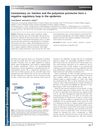TLDR Increasing SSAT makes skin more prone to cancer.
The study used transgenic mice with targeted expression of spermidine/spermine N1-acetyltransferase (SSAT) in hair follicle keratinocytes to investigate susceptibility to skin cancer. These K6-SSAT transgenic mice, bred onto a tumor-resistant C57BL/6 background, showed a 10-fold increase in epidermal tumors when exposed to a carcinogenesis protocol involving 7,12-dimethylbenz[a]anthracene and 12-O-tetradecanoylphorbol-13-acetate. The transgenic mice exhibited elevated SSAT activity and protein levels, along with increased putrescine and N1-acetylspermidine, indicating enhanced polyamine catabolism. The study concluded that this activation of polyamine catabolism might play a crucial role in chemically induced skin cancer, as evidenced by the early onset and progression to carcinomas in the transgenic mice.
54 citations
,
May 2001 in “Journal of Investigative Dermatology” Excessive putrescine causes hair loss in transgenic mice by disrupting hair follicle development.
43 citations
,
February 1999 in “Biochemical Journal” Overexpression of SSAT in mice causes hair loss, liver damage, and sensitivity to polyamine analogues.
233 citations
,
July 1997 in “PubMed” High levels of ornithine decarboxylase can cause tumors in mouse skin.
46 citations
,
May 1995 in “Proceedings of the National Academy of Sciences” A specific gene region can control targeted and responsive gene expression in mice, useful for skin disorder treatments.
37 citations
,
February 2005 in “Journal of Investigative Dermatology” Overexpression of SSAT causes hair loss and skin issues, but reducing putrescine can help.
10 citations
,
August 2013 in “Experimental Dermatology” Hairless protein and putrescine regulate each other, affecting hair growth and skin balance.
17 citations
,
July 2013 in “Amino Acids” Increased ODC activity leads to skin tumors by recruiting stem cells, not by toxic byproducts.
 30 citations
,
July 2010 in “Experimental Dermatology”
30 citations
,
July 2010 in “Experimental Dermatology” Polyamines are important for hair growth, but more research is needed to understand their functions and treatment potential.
 5 citations
,
October 2013 in “Experimental Dermatology”
5 citations
,
October 2013 in “Experimental Dermatology” The commentary explains that a balance of HR protein and putrescine is important for normal hair growth.

